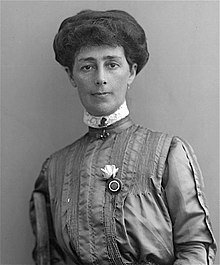
Back فيدا جولدشتاين Arabic فيدا جولدشتاين ARZ Vida Goldstein Catalan Vida Goldstein Welsh Vida Goldstein German Vida Goldstein Spanish Vida Goldstein Basque Vida Goldstein French Vida Goldstein Hungarian Վիդա Գոլդշտեյն Armenian
Vida Goldstein | |
|---|---|
 | |
| Born | 13 April 1869 Portland, Victoria, Australia |
| Died | 15 August 1949 (aged 80) South Yarra, Victoria, Australia |
| Nationality | Australian |
| Education | Presbyterian Ladies' College, Melbourne |
| Occupation(s) | Suffragette Social reformer Magazine editor |
| Known for | One of the first four Australian women to stand for parliament |
Vida Jane Mary Goldstein (pron. /ˈvaɪdəˈɡoʊldstaɪn/) (13 April 1869 – 15 August 1949) was an Australian suffragist and social reformer.[1][2] She was one of four female candidates at the 1903 federal election, the first at which women were eligible to stand.
Goldstein was born in Portland, Victoria. Her family moved to Melbourne in 1877 when she was around eight years old,[3] where she would attend Presbyterian Ladies' College. Goldstein followed her mother into the women's suffrage movement and soon became one of its leaders, becoming known both for her public speaking and as an editor of pro-suffrage publications. Despite her efforts, Victoria was the last Australian state to implement equal voting rights, with women not granted the right to vote until 1908.
In 1903, Goldstein unsuccessfully contested the Senate as an independent, winning 16.8 percent of the vote.[a] She was one of the first four women to stand for federal parliament, along with Selina Anderson, Nellie Martel, and Mary Moore-Bentley. Goldstein ran for parliament a further four times, and despite never winning an election won back her deposit on all but one occasion. She stood on left-wing platforms, and some of her more radical views alienated both the general public and some of her associates in the women's movement.
After women's suffrage was achieved, Goldstein remained prominent as a campaigner for women's rights and various other social reforms. She was an ardent pacifist during World War I, and helped found the Women's Peace Army, an anti-war organisation. Goldstein maintained a lower profile in later life, devoting most of her time to the Christian Science movement. Her death passed largely unnoticed, and it was not until the late 20th century that her contributions were brought to the attention of the general public.
- ^ Wright, Author's Note, "...the terms suffragist and suffragette are not interchangeable. Suffragists are people who advocate for votes for women. Men can be suffragists, and they were. The term is a generic description of a political position, akin to the terms socialist, capitalist or environmentalist. Suffragettes, by contrast, were a specific group of (mostly) women defined by their membership of certain suffrage organisations at a certain time in British history."
- ^ Wright, Clare (2019). You daughters of freedom: The Australians who won the vote and inspired the world. Melbourne: Text Publishing. ISBN 9781922268181.
- ^ Cite error: The named reference
andwas invoked but never defined (see the help page). - ^ 1903 – SENATE – VICTORIA Archived 3 August 2008 at the Wayback Machine, Psephos.
Cite error: There are <ref group=lower-alpha> tags or {{efn}} templates on this page, but the references will not show without a {{reflist|group=lower-alpha}} template or {{notelist}} template (see the help page).
© MMXXIII Rich X Search. We shall prevail. All rights reserved. Rich X Search